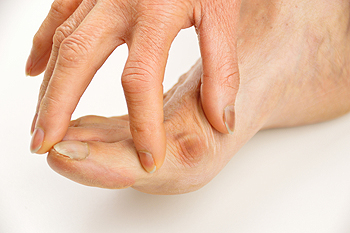Houston
Pearland
 A bunion is defined as a bone that grows on the side of the big toe. It is often a nuisance, and wearing shoes may become difficult. Symptoms can include redness, swelling, and corns that may form on top of the bunion as a result of excess friction. The common reason patients may develop bunions is wearing shoes that do not have adequate room for the toes to move freely in, or bunions may form due to genetics. Some patients find mild relief when a protective pad is worn over the bunion, and when supportive shoes are worn. Additionally, wearing custom made orthotics may bring the relief that is needed. In severe cases, surgery may be an option to consider for permanent removal. If you have bunions, it is suggested that you visit a podiatrist.
A bunion is defined as a bone that grows on the side of the big toe. It is often a nuisance, and wearing shoes may become difficult. Symptoms can include redness, swelling, and corns that may form on top of the bunion as a result of excess friction. The common reason patients may develop bunions is wearing shoes that do not have adequate room for the toes to move freely in, or bunions may form due to genetics. Some patients find mild relief when a protective pad is worn over the bunion, and when supportive shoes are worn. Additionally, wearing custom made orthotics may bring the relief that is needed. In severe cases, surgery may be an option to consider for permanent removal. If you have bunions, it is suggested that you visit a podiatrist.
If you are suffering from bunion pain, contact Dr. Linda D. Nachmani of Central Foot & Ankle Associates. Our doctor can provide the care you need to keep you pain-free and on your feet.
What Is a Bunion?
Bunions are painful bony bumps that usually develop on the inside of the foot at the joint of the big toe. As the deformity increases over time, it may become painful to walk and wear shoes. Women are more likely to exacerbate existing bunions since they often wear tight, narrow shoes that shift their toes together. Bunion pain can be relieved by wearing wider shoes with enough room for the toes.
Causes
Symptoms
In order to diagnose your bunion, your podiatrist may ask about your medical history, symptoms, and general health. Your doctor might also order an x-ray to take a closer look at your feet. Nonsurgical treatment options include orthotics, padding, icing, changes in footwear, and medication. If nonsurgical treatments don’t alleviate your bunion pain, surgery may be necessary.
If you have any questions, please feel free to contact one of our offices located in Houston, and Pearland, TX. We offer the newest diagnostic and treatment technologies for all your foot care needs.
Read more about Bunions